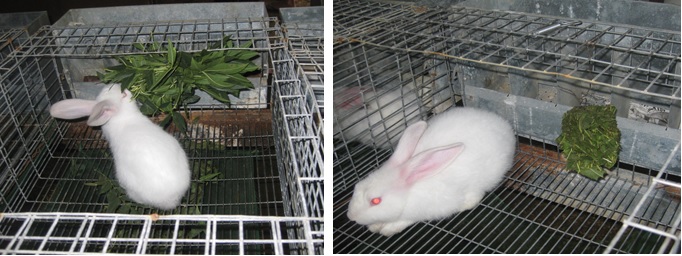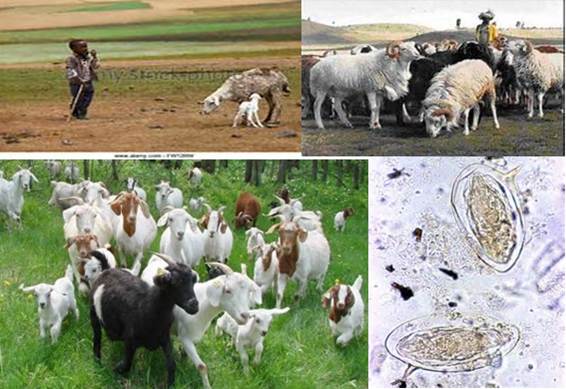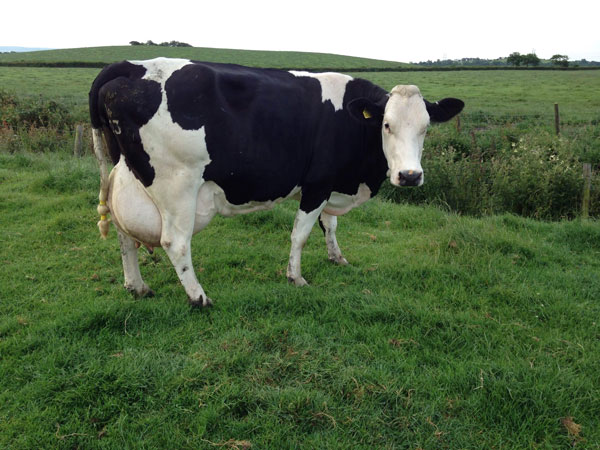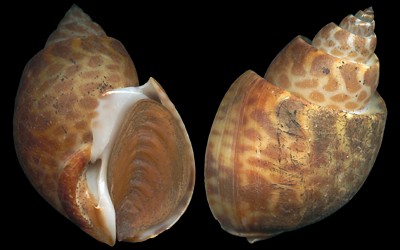Previous issue | Next issue | Archive
Volume 7 (4); July 25, 2017 [Booklet]
Nutritive value of ash leaves (Fraxinus angustifolia) for growing rabbits.
Djellal F, Kadi SA, Madani T, Abbas K, Bannelier C and Gidenne T.
Online J. Anim. Feed Res., 7(4): 72-78, 2017; pii: S222877011700012-7
Abstract
The digestibility and nutritive value of ash (Fraxinus angustifolia) leaves, harvested in autumn was determined (direct method), using ten rabbits (individually caged) weaned at 35d old (mean body weight: 911g) fed ad libitum only fresh ash leaves during 16 days. Ash leaves composition was: organic matter (OM) 89.3%, crude protein (CP) 14.6%, neutral detergent fibre (NDF) 39.4, acid detergent fibre (ADF) 28.3, acid detergent lignin (ADL) 16.1% on dry matter (DM) basis. The faecal digestibility of the ash leaves was measured between 48 and 52 day sold. The digestibility of OM, CP, NDF and ADF were 74, 67, 59 and 59%, respectively. The concentration in digestible energy and digestible protein of the ash leaves was estimated to 13.6±0.90 MJ/kg DM and 98±10.43 g/kg DM, respectively. In general, ash leaves harvested in autumn could be considered as a good source of fibre and energy for the growing rabbit. Therefore, Incorporating ash leaves moderately in a pelleted and balanced diet with a sufficient level of ingestion should be considered in ration formulation of growing rabbits.
Keywords: Ash leaves, Fraxinus angustifolia, nutritive value, autumn, digestibility, Growing Rabbits
Prevalence of small ruminants Schistosomiasis and its associated risk factors in Mecha district, Northwestern Ethiopia.
Assfaw F, and Samuel D.
Online J. Anim. Feed Res., 7(4): 79-85, 2017; pii: S222877011700013-7
Abstract
Schistosomiasis is a snail-born trematode infection of man and animal in tropical and sub tropical countries. It is an economically importance diseases caused by Schistosoma species and result in economic losses through mortality and morbidity from severe infection. A cross-sectional study was conducted from November 2014 to April 2015 in Mecha district, Northwest Ethiopia. A total of 384 fecal samples were collected from randomly selected sheep and goat in three peasant associations. The sample was processed with sedimentation technique to detect Schistosoma eggs by using light microscope. Therefore, the overall prevalence of Schistosoma infection irrespective of factors was found to be 9.4% (12.9% in ovine and 5.5% in caprine). In cases of sites where samples were collected, Kurtbahir showed higher prevalence (14.6%) than other two study sites (8.4% for Kudimi, and 4.2% for Enamrt). Age-wise prevalence of Schistosoma infection in sheep was significantly (P< 0.05) varied. Similarly significant association of Schistosoma infection with age and body condition score also observed in ovine population (P< 0.05), not in caprine. Species-wise prevalence Schistosoma infection in sheep and goat was significantly (P< 0.05) varied. However, Schistosoma infection did not affect (P> 0.05) by sex in both species. In general, Schistosomiasis is one of the major health concerns of livestock production. Therefore, control of schistosomiasis based on drug treatment, snail control and appropriate sanitation measures were recommended.
Keywords: Small ruminants, Schistosomiasis, Sedimentation, Prevalence, Mecha district, Ethiopia
Gene segregations, linear body measurements and performance evaluation of dairy cattle crossbreeding in Northwestern Ethiopia
Getu A, Guadu T, Addisu Sh, Assefa A, Mogese N, Chanie M, Bogale B, Birhanu M, Alebie A, and Feresebhate A
Online J. Anim. Feed Res., 7(4): 86, 2017; pii: S222877011700014-7
Abstract
An investigative research work was delivered to address the objective of characterizing the cross breeding effects on dairy cattle performances in North West Ethiopia (North Gondar, South and west Gojam). In the same time, exploratory field survey and multistage sampling technique was conducted to collect the polygenic traits and improvement effects of cross breeding in the study areas. Blood level like F1 (50E:50L), F2 (25E:75L), F3 (75E:25l) and F4 (12.5E:87.5l) dairy cattle characterization work was conducted from north Gondar, south Gondar and west Gojam zone. The interaction effect of body weight and other liner body measurements for all dairy cows with different blood levels were highly significant (P< 0.01). Body weight and body length at F3, F2, F1 and F4 blood levels of the cows were indicated that none, little and significant (P< 0.01) reduction were observed on the measurable trait values across the blood levels like body weight least square mean value of 405.86, 405.72, 401.38 and 346.13 (kg) and 184.78, 182.32, 178.68 and 169.59b (cm) for body length, respectively. Whereas, performances of cows were reduced as exotic blood levels were increased. So, this work remarked that F1 generation of an animal had superior in different aspects, while the gene segregation effect was observed at F3 (75E:25l) generation. Similarly, the factorial ANOVA indicated that peak milk yield (12.83lt/day) was measured from parity three and F1 generations. Therefore, gene segregation and down crossing effect could be the causes of economic losses and should be flew the bloods through generations. In addition, characterization of the randomly disseminated genetic resources should be employed to evaluate and know the breeding practices and effect of the merit or demerits of cross breeding in the country.
Keywords: Measurable Traits, Crossbreeding, Genetic Improvement, Cattle, Amhara
Effect of new formulated diets on growth and biochemical parameters of Babylonia spirata (Lin, 1758), gulf of Mannar.
Chelladurai G. and Karthick N.
Online J. Anim. Feed Res., 7(4): 91-96, 2017; pii: S222877011700015-7
Abstract
A feeding experiment of three dietary protein levels (30%, 35% and 40%) with three replicates was conducted to determine the proper protein level for the growth and survival of the Babylonia spirata under laboratory conditions. Snail with initial body weight ranged from 50.95 ± 0.33g to 51.05 ± 0.21g and initial length ranged from 5.96 ± 0.62 cm to 6.91 ± 0.70 cm were fed the experimental diet for 3 months. Mean weight gain, survival rate, biochemical parameters of snail fed the 40 % protein diets was significantly (P<0.05) different from that snail fed the 30% and 35%. The results of the study indicate that a diet containing 40 % dietary protein was recommended for snail growth under our laboratory conditions.
Keywords: Formulated diet, Growth, Biochemical parameters, Babylonia spirata
Previous issue | Next issue | Archive
This work is licensed under a Creative Commons Attribution-NonCommercial 4.0 International License.
| < Prev | Next > |
|---|







